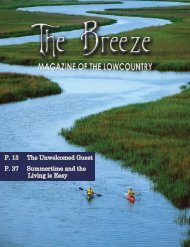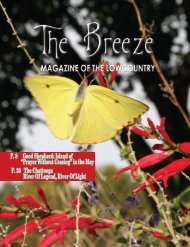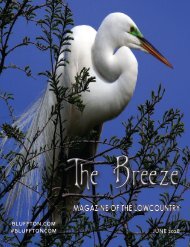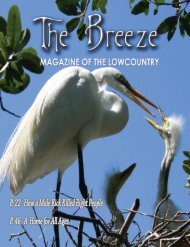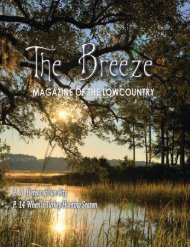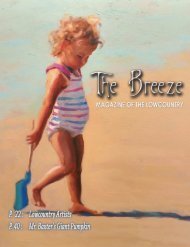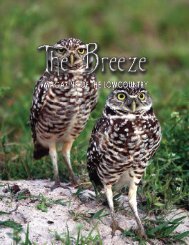The Breeze Magazine of the Lowcountry JUNE 2020
Create successful ePaper yourself
Turn your PDF publications into a flip-book with our unique Google optimized e-Paper software.
<strong>The</strong> <strong>Breeze</strong> <strong>Breeze</strong> Music Environment<br />
<strong>The</strong> Unwelcomed Guest<br />
By Amber Hester Kuehn<br />
I didn’t grow up hunting and have no experience<br />
with shot guns. In my experience, Girls Raised in<br />
<strong>the</strong> South who had bro<strong>the</strong>rs typically lack this skill,<br />
and those that I know who are pr<strong>of</strong>icient with a<br />
shot gun had sisters or no siblings at all. I think I<br />
could have been good at it and regret not spending<br />
more time in <strong>the</strong> woods. Instead, <strong>the</strong> creeks and<br />
rivers were my stomping grounds -- <strong>the</strong> buffer<br />
zone where four legged meets fin, <strong>the</strong> maritime<br />
forest is inhabited with familiar faces from <strong>the</strong><br />
boating perspective. Deer lick marsh grass for <strong>the</strong><br />
salt, alligators take a salt water bath from time to<br />
time to rid <strong>the</strong>ir scales <strong>of</strong> algae or to migrate to<br />
a new freshwater pond, raccoons eat periwinkle<br />
snails, crabs, and almost anything that <strong>the</strong>y touch.<br />
At night, <strong>the</strong>y all became shiny eyes with vague<br />
outlines.<br />
But somewhere in <strong>the</strong> midst <strong>of</strong> those familiar<br />
faces shine eyes <strong>of</strong> an unwelcomed guest who is<br />
breaching my comfort zone...<br />
A new foe!<br />
<strong>The</strong> 2013 Hilton Head Island sea turtle nesting<br />
season was almost over when it began. At some<br />
point in <strong>the</strong> night on August 24, a new predator<br />
had emerged from <strong>the</strong> 605-acre maritime forest<br />
preserve in Sea Pines. Nest #245 (<strong>of</strong> 339) with<br />
109 incubating sea turtle eggs had been totally<br />
destroyed. <strong>The</strong> area, full <strong>of</strong> canine prints and<br />
thrown sand combined with egg chards, lead<br />
<strong>the</strong> sea turtle patrol staff to assume that it was a<br />
wayward pet left unattended while <strong>the</strong> incident<br />
took place. Documented as an unforeseen loss, it<br />
was considered an isolated event.<br />
Two weeks later, we changed our minds. <strong>The</strong><br />
attacks began to happen regularly, and despite<br />
adding screens supplied by SCDNR (South Carolina<br />
Department <strong>of</strong> Natural Resources), <strong>the</strong> predator<br />
found a way to invade <strong>the</strong> nest by tunneling under<br />
<strong>the</strong> screen. <strong>The</strong>ir learning curve was surprisingly<br />
fast. Each time, most <strong>of</strong> <strong>the</strong> contents <strong>of</strong> <strong>the</strong> nests<br />
within reach were fully consumed. This predator<br />
was hungry and most likely did not eat pedigree<br />
from a bowl! Also, <strong>the</strong> effort put forth to tunnel<br />
was a bit more ambitious than most dogs would<br />
undertake, so we had to assume that <strong>the</strong>re was at<br />
least one coyote in <strong>the</strong> area! Our suspicion was<br />
confirmed by experts who studied <strong>the</strong> footprints<br />
(coyote prints are very similar to that <strong>of</strong> a dog – just<br />
slightly narrower). At <strong>the</strong> end <strong>of</strong> <strong>the</strong> 2013 season,<br />
nine sea turtle nests were lost to <strong>the</strong> coyotes. Four<br />
o<strong>the</strong>r sea turtle nesting beaches in SC, including<br />
Kiawah, have recently reported <strong>the</strong> coyote issue<br />
as well.<br />
How did <strong>the</strong>y get here?<br />
When I think <strong>of</strong> coyotes, I picture desert mountain<br />
ranges and Wild West instead <strong>of</strong> plantations and<br />
gated communities. Coyotes are not indigenous<br />
(native) to <strong>the</strong> <strong>Lowcountry</strong>. Historically, <strong>the</strong>y were<br />
limited to <strong>the</strong> Midwest and Mexico. After 1700, <strong>the</strong>y<br />
began expanding <strong>the</strong>ir<br />
range, and are currently<br />
found throughout <strong>the</strong><br />
continental US, Alaska<br />
and most <strong>of</strong> Canada.<br />
Coyotes first appeared<br />
in South Carolina in 1978<br />
in Oconee County, <strong>the</strong><br />
westernmost county<br />
in South Carolina<br />
(“Upstate”), seemingly<br />
far from sea turtle<br />
nesting<br />
13




